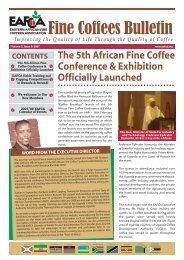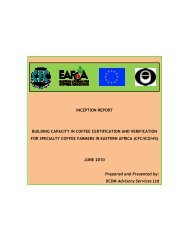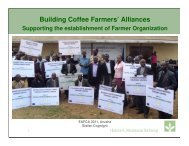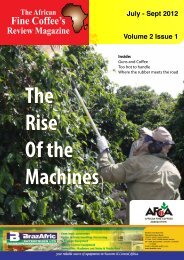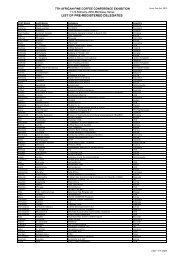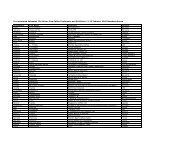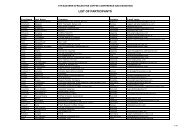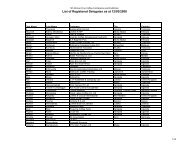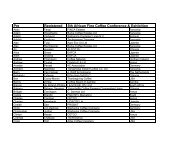African Fine Coffees Review Special Edition Oct-Dec - EAFCA
African Fine Coffees Review Special Edition Oct-Dec - EAFCA
African Fine Coffees Review Special Edition Oct-Dec - EAFCA
Create successful ePaper yourself
Turn your PDF publications into a flip-book with our unique Google optimized e-Paper software.
40<br />
Kenya:<br />
Kenya has seen stagnated production despite good prices for its coffee over the last 5 years with an<br />
average of just below 50,000 mt. Two likely reasons for this are the conversion of coffee plantation<br />
land into real estate and the higher cost of production as the economy grows. It is therefore<br />
likely that production in Kenya may decline further as new planting in the west is initially likely to lag<br />
behind lost production in central. Several initiatives to slow this trend include waiver of old debts owed<br />
by cooperative producers and release of new disease resistant varieties to farmers. The outcome of this<br />
scenario is that marginal farmers<br />
are exiting the scene leaving serious<br />
ones who are concentrating on<br />
quality. It is therefore expected that<br />
the quality coming out of Kenya<br />
will be enhanced with a higher<br />
percentage of specialty coffee.<br />
Figure 2: Kenya 7 Year historical<br />
Coffee Sales (Auction)<br />
Tanzania:<br />
Tanzania crop has been steady but cyclic oscillating between 35,000 tons on the down cycle and<br />
55,000 tons and the up cycle. It is therefore expected that the 2012/13 crop will come in at<br />
about 55,000 tons with 60% Arabica and the balance Robusta. With 90% of production coming<br />
from smallholder farmers, productivity is a challenge. However, herein lies the opportunity to increase<br />
productivity from currently 0.25 kg per ha to 1 kg per ha. The authorities are also encouraging new<br />
plantings to raise coffee acreage by 50%.<br />
With sustained good Robusta prices, the<br />
trend for Tanzania is likely to be upwards.<br />
For Arabica, there is concerted effort to<br />
improve on quality of southern coffees<br />
through centralized primary processing.<br />
Figure 3: Tanzania Historical Coffee Sales<br />
(Auction)<br />
Ethiopia:<br />
Ethiopia has seen increased production and export over the recent 5 years. Official figures show<br />
that exports peaked at 196,000 tons in 2010/12. This trend is likely to continue despite growing<br />
local consumption. Smallholder farmers account for 95% of production with. low productivity<br />
is a challenge meaning the opportunity to increase yield exists. There are 2 marketing channels, with<br />
almost all smallholder coffee selling through the ECX (coffee Auction). Direct export model, open to<br />
commercial farmers and large cooperative unions is under pilot. Major Ethiopian coffees qualities are<br />
65% sundried naturals, 25% Sidamo, Limu, Tepi and Bebeca, 6% Harrar, 4% washed yirgacheffe, and 1%<br />
special preps.<br />
Figure 4: Ethiopia 7 Year<br />
Historical Production and<br />
Exports






